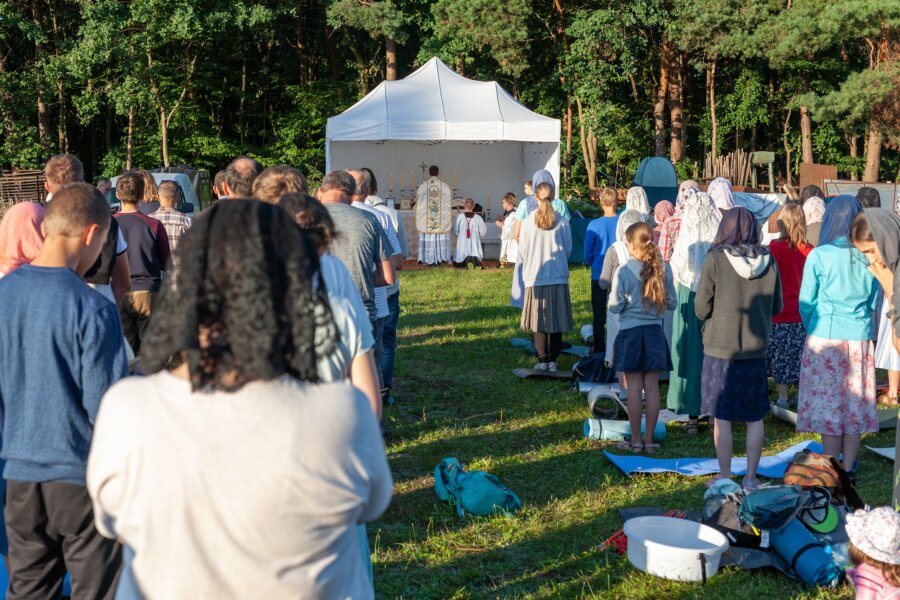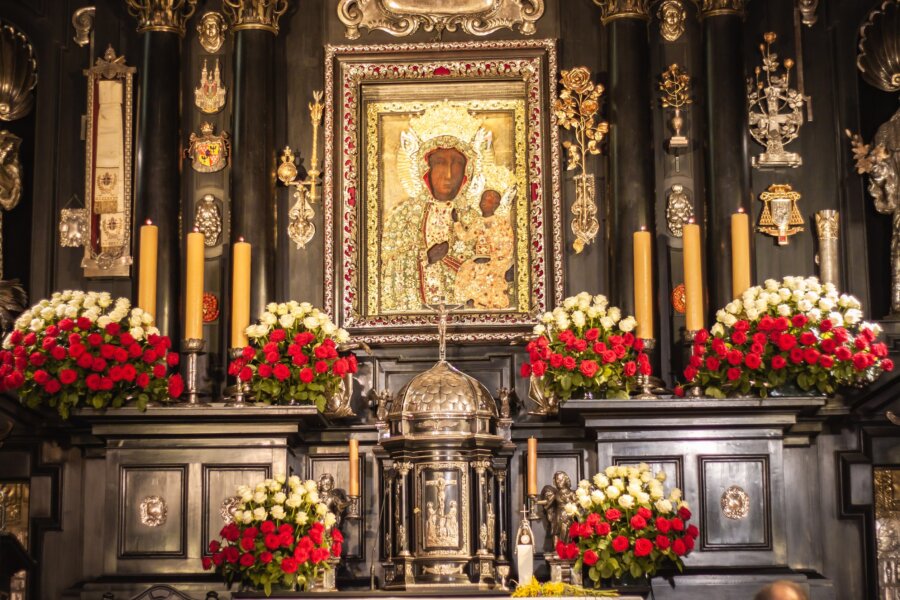Above: Jasna Góra in the distance. All photos by Paweł Rywolt used with permission.
Editor’s note: as we discussed in our post about the greatness of Catholic June, this month is a perfect opportunity to commit now to a penitential pilgrimage to offer for the conversion of sinners. Sign up for this pilgrimage here (English is spoken on the pilgrimage).
It’s about the fifteen hundredth time I’m singing the Hail Mary in Latin, and I’m sweating bullets as the hot August sun hangs overhead. After almost 300km (200 miles) and 11 days on foot from Warsaw, muscles are sore, feet are covered with blisters and the only sense of relief is the sight of the spire in the distance, the final destination. Only a few more kilometers left, I tell myself. I’m on the last stretch of a pilgrimage to the Jasna Góra Monastery in Częstochowa from Warsaw with the SSPX. We aren’t alone, there are groups coming from all corners of Poland some travelling much longer distances.
History about the Częstochowa Pilgrimage
There are 96 pilgrimage destinations in Poland, none however are as popular as Jasna Gora in the center of Częstochowa which is the spiritual heart of the Polish nation. Most groups arrive for the feast day of the Assumption, (August 15th) a holiday in Poland with national significance for many reasons including the apparition of the Blessed Virgin and the consequent defeat of the Bolshevik invasion of Poland in 1920. Pilgrims are motivated to come to the Jasna Gora monastery with petitions or gratitude that they would like to give to God through the hands of His Blessed Mother.
The first recorded pilgrimage to the Jasna Góra Monastery left the city of Gliwice in September 1626 in order to thank the Blessed Mother for her help in saving the city from a Danish siege during the Thirty Years War. The city promised to make the pilgrimage an annual event.
The second recorded pilgrimage was from the city of Kalisz, which began in 1637 and the third from Łowicz in 1656. The pilgrimage from Warsaw left the first time on August 6th in 1611. Last year there was 80.5 thousand pilgrims from all over Poland which is a drop from the 145 thousand in pre-“pandemic” 2019 season and the recorded 300 thousand pilgrims in 1989, right after the fall of communism in Poland.
The SSPX Pilgrimage Experience
This is not my first pilgrimage to Częstochowa, my first one was four years ago with a large group that did the whole pilgrimage on rollerblades. Most people, myself included treated it as a fun way to do lots of rollerblading and meet new people. Since then I have turned to Catholic tradition and this time I had some important petitions I wanted to request of our Blessed Mother. Therefore this year I chose to do a more penitential pilgrimage on foot with the SSPX.
This year’s pilgrimage was the largest for the SSPX thus far. The spaces filled up very quickly after registration opened, and an extensive waiting list started to form. For pastoral reasons, the organizing priest wanted to ensure that everybody who wanted to go on the pilgrimage could go so at the last minute everybody on the waiting list was given a place. Rumor has it that the organizers were ready to order more showers to accommodate the record sized group. However the head priest said “over my dead body” as this is supposed to be a penitential pilgrimage. Over 300 pilgrims had to make do with four shower cabins that had only cold water.
The first few days of the pilgrimage were through unrepentant heat in the cloudless sky. Everyone wanted to complain but nobody could, given that the priests were in black cassocks and never uttered a word about it. The smiles persisted nonetheless. When the rain did come, it was a complete surprise and relief. The boys being chivalrous gave their jackets to the woman who left their raincoat in the baggage and were caught off guard by the rain.

The second and third days of walking destroy any notion that this is simply an extended version of a walk in the park. Remember that sprained ankle you had four months ago and you thought was perfectly healed? Well you’re going to feel it and realize it’s not. Although there is much to complain about, no one does, because everybody is in the same boat, on the same mission. From young children to seniors and everyone in between. Even the most physically fit men suffered through the trip. It’s the little children that seemed to manage the best, after a whole day of walking twenty miles they would have the energy to play a game of soccer. Despite the pains that develop and get progressively worse over a day of walking, somehow by the grace of God they disappear the next morning, a phenomenon that was universal among the pilgrims.
There is no need to set an alarm in the morning as the rustling of pilgrims crawling out of their tents and their “dzien-dobry” are more than enough to wake you up to get ready for daily Mass at 6:30am. Some people come 15 minutes early for morning prayers. There is nothing like standing up in the cool misty morning air each morning in the quiet bustle of a pilgrims’ campsite, quickly brushing one’s teeth by the communal water hose and then participating in a sung Traditional Latin Mass. After Mass is breakfast with fresh bread and your choice of cheap Polish pate or marmalade. After breakfast and some coffee the tents are folded, baggage packed and tossed into the truck, not to be seen again until arriving evening at the next campsite, laid out ready to be picked up and unpacked.

Once the field was cleared and everyone had their baggage in the truck the group would begin every march singing Cristus Vincit and Sancte Pie Decime, to be repeated throughout the day after each precious break. Every day during the march, the Little Office of our Lady would begin and then accompanied by three sung Rosaries throughout the day as well as the Angelus in Latin.
Each decade of the Rosary was led by a different person with a microphone with the Hail Mary’s sung in a different melody for each decade, some pilgrims counted six different melodies. There were two priests, one that would lead the prayers of group and another that would always be at the back of the column ready to hear confessions or provide spiritual guidance. The pace of the group was set by the person at the front that would hold the cross as well as one that would hold an icon of our Lady of Częstochowa. The rule was that nobody goes in front of the cross. Everybody was given a pilgrims prayer and song book from which the group would sing and pray from daily.

Even though this is a traditionally Polish pilgrimage, this year there were faithful from Hungary, Czech Republic, Switzerland and a good old bean from the UK. Most years there is a group from Saint Mary’s Kansas, this year there wasn’t, likely due to COVID restrictions for travel from the United States.
Over the 11 days of walking through rural Poland you notice the differences in different regions where some areas specialize only in apples, others in blueberries, dairy or peppers in greenhouses. We walked through fields, orchards, forests, bridges, dusty roads, asphalt and crossed wide rivers. As we walked through the dairy region, the herds of cows would always approach the group from the fields where they were grazing at the sound of sung songs and rosaries. If there was no fence then they would most certainly join the pilgrimage.

The route this year was slightly different from the one last year. It is customary that that the organizers call the parish in each village that we pass and inform them when we will pass by. Many promise to provide some refreshments and snacks for the pilgrims. Then the whole village collects money and prepare homemade cakes, drinks, and water for the pilgrims and patiently waited for us to arrive where we were given a heroes welcome. Many churches rang the bells to welcome us. The villagers put their heart into preparing the food and snacks and were grateful that they have the opportunity to help us. Often the villagers would give us produce that was picked straight from their farms, this is where I had a taste of the biggest and juiciest blueberries I ever had. Even as we passed small villages without a church the locals would come out of their homes to greet and wave at us. Seeing old ladies with tears in their eyes as they watched us pass was rather overwhelming. Everywhere we passed, we gave out religious pamphlets based on Traditional Catholic Faith to people as well as dropping them in mailboxes.
One of the most memorable moments was singing “Te Deum Laudamus” in Polish before arriving at the final campsite of the day. Every song always sounds better in the original Latin version, the only exception to this is the Polish Version of Te Deum Laudamus which is glorious with beauty that surpasses even the original Latin version. As we approach the final campsite, the reality of four shower stalls for over 300 people quickly becomes evident as young people start to gather at the front of the column just behind the cross that they cannot pass. Then as the cross passes into the campsite the line breaks and they race to the shower stalls to at least reserve a spot in line if not jump right in for the ice-cold shower. I found the best strategy is to be behind the racing group and reserve a spot which allows sufficient time to find luggage, unpack, set-up the tent and eat dinner before it being my turn for a shower. The lineups for an ice-cold shower unsurprisingly lasted well into the night. Many people give-up even trying to get a spot and instead showered every-other day or improvised with a bucket and sponge in the bushes. Despite the competition everyone is in good humor. A custom developed where everyone applauded as people left the shower as if they were rockstars.
As the camp gets set up people also form lineups to the medics to deal with painful effects of the arduous walk, most of the work involved lancing blisters on peoples feet. The head medic had a great sense of humor and always made people laugh. Notably when a young medical student was lancing a blister on the foot of a young girl, the medic joked it was a good test for marriage as everyone exploded in laughter in the ensuing visible awkwardness of the poor lad as he was holding the needle to her foot.
It’s a Polish tradition that every day at the Jasna Gora Monestary at 9:00pm there would be sung the “Apel Jasno Górski” which would be the song “Bogurodzica” (The Mother of God) which used to be an anthem of the First Polish Republic. This tradition would be continued on the campsite every evening. You could hear the choir practice each night for mass next morning. Some people are devoured by hardy Polish mosquitoes, others aren’t troubled at all. There were many days where at the end of the day you knew with almost certainty that there is no way you can continue the next day without taking the ride of shame if you didn’t take painkillers, but somehow you managed without either.
How the pilgrimage with the SSPX differs from other Novus Ordo Pilgrimages
The experience between this pilgrimage with the SSPX and all the other “Novus Ordo” pilgrimages is vast. Here people treated the aspect of faith seriously and embraced the penitential aspect of the pilgrimage which is what a pilgrimage should be. Unlike the other pilgrimages, here there was a strict traditional dress code for woman that they could only participate in skirts, pants weren’t allowed as pants are for men. Most prayers were in Latin not Polish which was helpful for the participants that were not Polish, even if only a small minority. The daily conferences by the leading priest touched on traditional aspects of Catholic faith and theology.
Once we arrived at the Jasna Góra Monestary, we quickly went to the main chapel where the original image of Our Lady of Częstochowa is present to offer our petitions to the Blessed Mother. We then went to pick-up our bags, said our goodbyes and went home.

Aftermath
After returning to the pagan world (even in “pious” Poland) after 11 days of a penitential pilgrimage you notice things you normally wouldn’t such as how immodestly women are dressed when before you considered it normal. The different melodies of the Ave Maria in Latin constantly running in circles in my head.
After about two weeks from the end of the pilgrimage a question was asked in a group chat on what do people miss the most about the pilgrimage. People mentioned that they missed the communal prayers, the daily pastoral care, the kindness of the people, daily mass, the family-like atmosphere, the trust and belief in the goodness of others, the conviction that from morning to night one is doing something for the Glory of God, the set plan and daily discipline to stick to it which didn’t allow much time to think about ones own affairs. Surprisingly enough, all agreed that they would be willing to even walk for 30 miles daily if it meant they could continue the pilgrimage instead of returning to the daily grind.
At the end of it all, however, there remains a lingering sense that we have done right by Jesus and Mary and that our little pains which we hardly dare presume to call sacrifices have won graces for the world to which we return and continue to bear fruit until next year.


